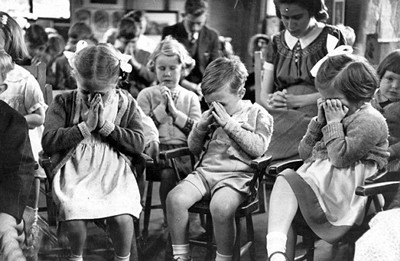Books and arts
文藝
Bookreview
書評
Post-war Britain
戰后英國
When the tide turned
變革之后
Modernity Britain: Opening the Box, 1957-59. By David Kynaston.
《打開歷史,認識1957-1959年間的英國現代主義》
EARLY in 1959 passengers on a London tube train defied an announcer's instruction to “all change”, before being thrown off by police.
早在1959年,倫敦地鐵廣播員下令所有乘客遵循指令,沒有接受指令的乘客們就被警察趕下了地鐵。
They had wanted, a witness told the Times, “to know what the reason was”.
接受《時代》周刊采訪的目擊者表示,他們想知道原因。
They were tired of being treated “habitually and consistently as unreasoning cattle”.
因為他們已經受夠了一直被人當作亂跑的牛群一樣隨意驅趕。

A stirring from bovine deference was widespread in late 1950s Britain.
二十世紀50年代末,英國消費者不再尊崇發展緩慢的事物。
A consumerist surge helped reshape traditional working-class culture.
消費主義的興起重新塑造了傳統的工薪階層文化。
Two-thirds of homes had a television by 1959, up from 45% just two years earlier.
截止到1959年,三分之二的家庭擁有電視機,與兩年前45%的擁有率相比有所增加。
Tripe and dripping were on the slide; the brand-laden aspiration of Ian Fleming's bestselling Bond novels was on the rise.
流油的美味內臟出現在幻燈片上;人們對于伊安弗萊明的007系列暢銷小說的越來越追捧。
Private house-building overtook that of local authorities.
私人建房的數量要超過地方政府的建房數量。
Modernist architects wrought their iconoclasm in city centres and university campuses.
現代主義建筑師在城市和校園中用他們的作品展現著對傳統觀念的破壞。
Students covered a home secretary in flour and foam.
學生們能夠雇得起家庭廚師。
The country was getting into the swing of the 1960s.
整個國家全身心地投入到二十世紀60年代中去了。
But not all were limbering up.
不過,也不是所有人都行動一致,開始接受變化。
A mobbed rock 'n' roll star wished “the kids would show more restraint”.
一個暴徒般的搖滾明星表示希望孩子們能更加克制。
Women were still burdened with domestic drudgery.
婦女仍然為家事所累。
Asked about the latest consumer durable, many men said, “I don't need one, my wife is my washing machine.”
每當被問到最新的耐用消費品時,很多男人會說:“我不需要,我老婆就是個洗衣機。”
The liberalism of the next decade was more marked among politicians than the people.
未來十年,政客身上體現的自由主義會比人民要明顯。
At a time when most Britons wanted to impose a “colour bar” on immigration, the one Tory MP who suggested such a restriction in Parliament was humiliated and reduced to tears at a party meeting.
當大部分英國人想要在移民政策上添加種族色彩的條款時,托利黨的一位議員認為這樣的條款讓人無地自容,議會里不應該有這樣的規定,為此他灑淚黨內會議。
“Modernity Britain”, the third installment of David Kynaston'schronicle of post-war life, captures a society on the edge of change.
《英國現代主義》是大衛基納斯頓描寫戰后生活系列的第三本書。書中,他描寫了處于變革邊緣的英國社會。
The author is fascinated by the ordinary.
他非常喜歡描寫英國社會下的普羅大眾。
He flits from the diaries of a suburban housewife to those of the prime minister, and back to provincial obscurity with the letter pages of the regional press.
從郊區家庭婦女的日常生活到首相的日常安排,再到地方媒體上的爆出來的信件里的小道消息,通通都是他描寫的對象。
Through it all he conveys 1950s life more vividly than any historian before him.
他筆下的二十世紀50年代,比他之前的任何一位歷史學家,都要生動的多。
Mr Kynaston is mostly content to let his sources do the talking. But the anti-elitism of his methodology occasionally finds its way into his analysis.
基納斯頓很欣慰看到自己寫的東西能帶來一些影響,但是讀者偶爾會從他的分析中發現反精英思想。
An excellent riff on “meritocracy”, a term that was popularised by a sociologist named Michael Young in 1958, ends with a bruising critique of grammar schools.
精英主義這個詞是在1958年一名叫麥克楊的社會學者使用后開始流行,開始變得讓人敬畏的。直到文法學校受到嚴厲批評,對于該詞的重復引用才算告一段落。
When a professional cricketer running in to bowl sees his England teammate,a posh amateur,practising his golf swing, the author's tut is all but audible.
一名專業的板球運動員跑出場外去觀看英格蘭的隊友,一名動作優雅的業余球員揮舞高爾夫球桿時,作者的嘖嘖贊嘆聲此起彼伏 。
Just after the 1959 general election a cartoon depicted the patricianHarold Macmillan, re-elected as prime minister, sitting beside a fridge, a car, a washing machine and a television.
就在1959年大選之后,有這樣一幅漫畫,描寫的是出身貴族的羅德麥克米倫再次當選首相,在他周圍擺放的是冰箱,車子,洗衣機和電視機。
“Well, gentlemen,” he says, “I think we all fought a good fight.”
他說:“各位,我覺得我們干的不錯!”
Post-war austerity had thawed, and the country had entered a consumerist, “candyfloss world”.
戰后的財政緊縮已經開始緩解,整個英國已經進入一個像棉花糖一樣美好的消費時代。
The Tories, unlike the Labour Party, had woken up to this.
與信仰清教,一直到1951年后就再也沒有執政過的工黨不同的是,托利黨人已經意識到了這一點。
The masterful “Modernity Britain” enables new readers to do so too.
《英國現代主義》這本書寫法一流,許多新讀者也開始紛紛效仿書中的做法。











